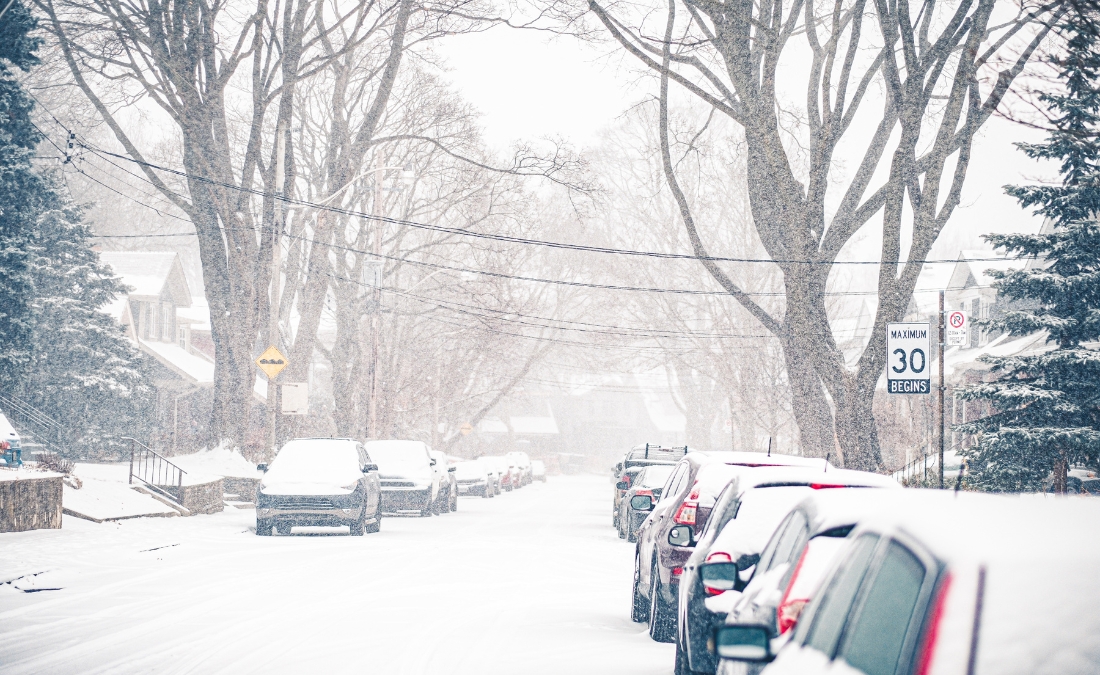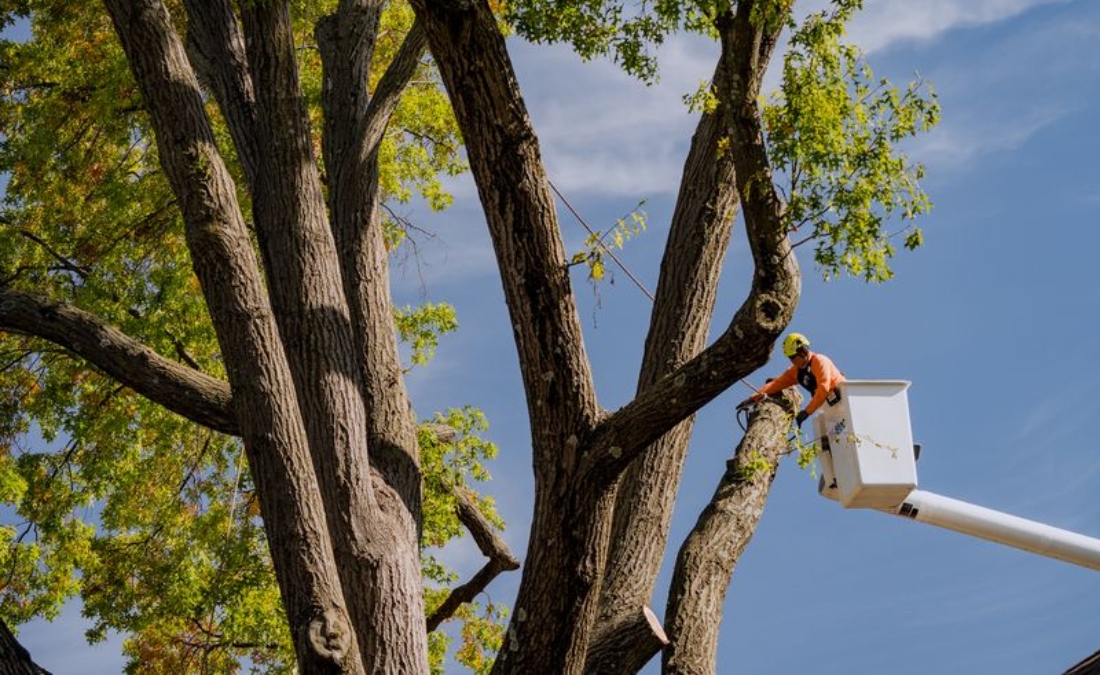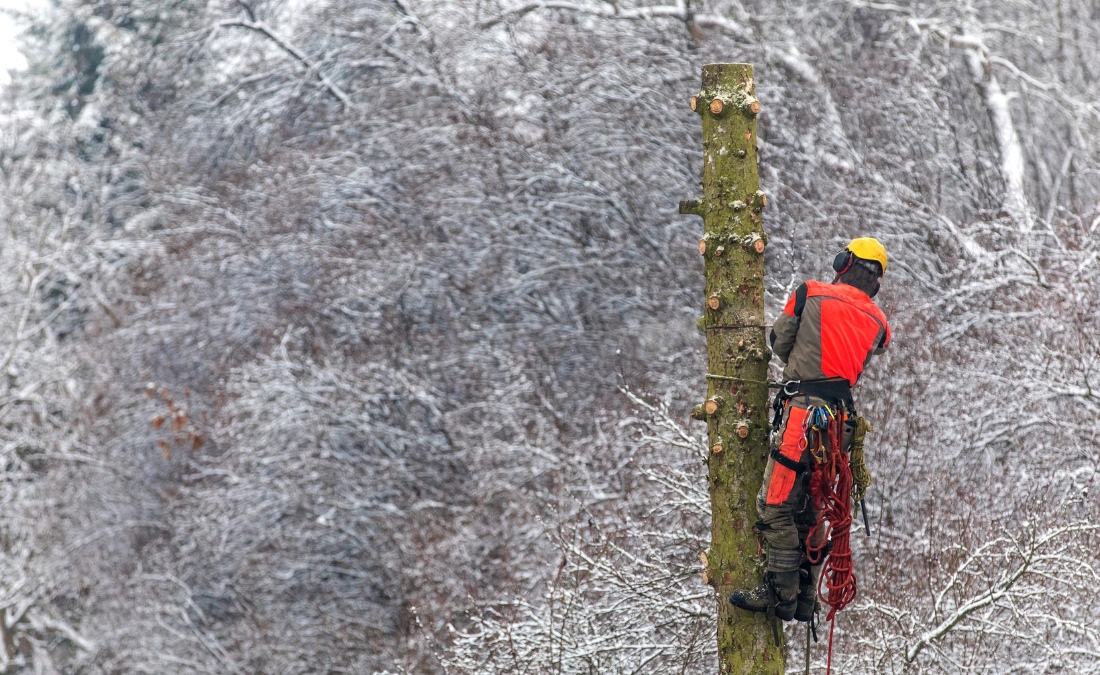Oak Wilt: The Tree Disease You Can’t Afford to Ignore
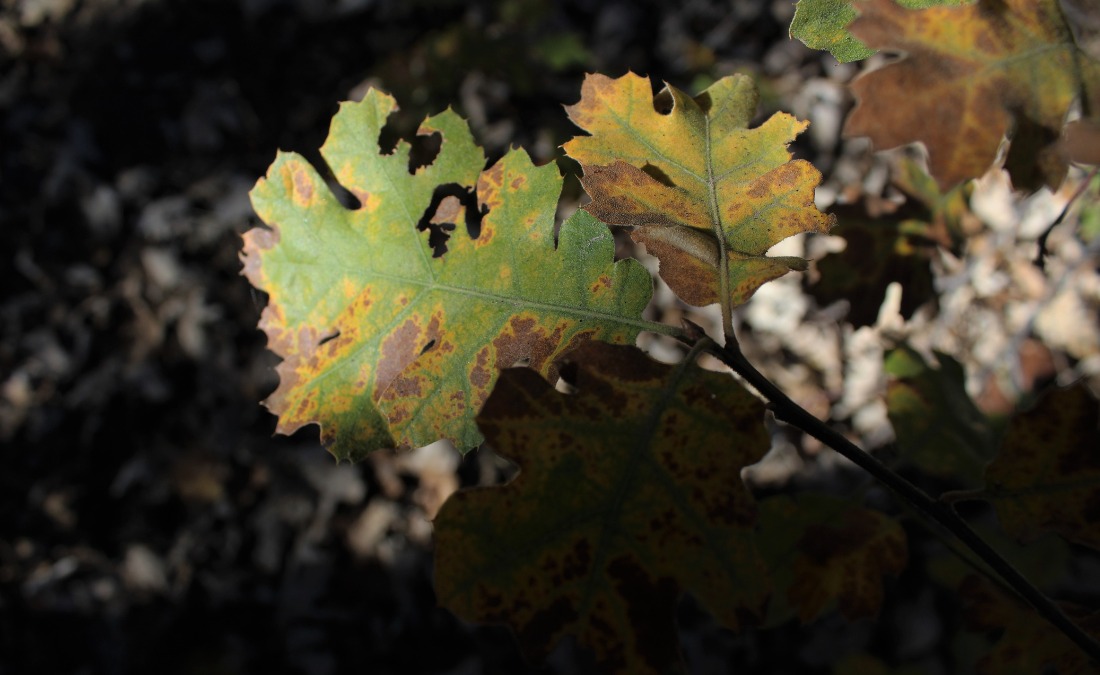
Think your oak tree is stressed? It could be oak wilt. Learn the signs, common misdiagnoses, and why early detection is critical for your trees.
When homeowners see their oak trees dropping leaves or turning brown in the middle of summer, it’s easy to assume it’s a treatable problem, like drought stress, insect damage, or leaf scorch. Unfortunately, this time of year, these symptoms could also indicate something much more serious: oak wilt.
Because oak wilt can look like other common issues, homeowners often wait too long to call a Certified Arborist. And with this disease, time matters. Once oak wilt shows up, the focus isn’t just on the infected tree, but on protecting every other healthy oak nearby.
Key Takeaways:
- Oak wilt is a fast-moving, fatal fungal disease that blocks water flow inside oak trees, leading to rapid decline and death.
- Because symptoms mimic drought or leaf scorch, many homeowners miss the early warning signs, giving the disease time to spread.
- Once symptoms show, there’s no cure for the infected tree, so the priority shifts to protecting surrounding healthy oaks.
- Red oaks die quickly and spread the disease easily, while live oaks can silently infect others through root connections.
- Even light pruning or branch removal can accelerate infection – always call a Certified Arborist before disturbing a symptomatic oak.
What Is Oak Wilt?
Oak wilt is a vascular disease caused by the fungus Bretziella fagacearum. It affects oak trees by blocking the vessels that transport water and nutrients from roots to leaves (also known as the xylem). Once infected, the tree begins to wilt from the inside out, eventually dying if action isn’t taken quickly.
Oak wilt has been confirmed in more than 20 U.S. states, but its impact is especially severe in areas with dense oak populations, like the Midwest, South, and parts of the Northeast.
What Causes Oak Wilt to Spread?
There are two primary ways oak wilt spreads:
- Beetle Transmission: Sap beetles are drawn to fresh wounds on oak trees, like those created during pruning or storm damage. If the beetle carries spores from an infected tree, it can deposit them into a new host tree through the wound.
- Underground Root Grafts: Oaks that grow close together often form natural root grafts, especially red oaks and live oaks. These root systems allow the fungus to travel directly from one tree to another without ever being exposed above ground.
What Makes Oak Wilt So Dangerous?
Oak wilt isn’t just a nuisance – it’s one of the most aggressive and costly tree diseases in the country. What sets it apart is how little warning it gives and how difficult it is to contain once it’s established.
It Spreads Fast
With oak wilt, there’s very little margin for error. By the time the disease becomes visible, it’s already too late. What makes this especially dangerous is how easy those early symptoms are to miss or misdiagnose. That delay in recognition gives the disease time to move beyond the original tree, reducing your options for containment.
It Doesn’t Just Kill One Tree
The real danger of oak wilt lies in its ability to jump from tree to tree. That means a single infected tree isn’t just a loss – it’s a launch point. In neighborhoods, parks, or wooded lots, this disease can take out entire strands of trees before you realize it’s spreading.
It’s Always Lethal
Some diseases weaken trees slowly, giving you time to react. But with oak wilt, the speed and severity depend heavily on the type of oak you’re dealing with.
- Red Oaks: Pin oaks, northern reds, and black oaks are what we consider the early casualties. Once symptoms appear, trees often die within 2 to 4 weeks.
- Live Oaks: Though they may decline more gradually, their interconnected roots make them dangerous hosts. A single infected live oak can lead to widespread damage across your entire property (or your neighbor’s), making containment especially difficult.
- White Oaks: Bur oak, swamp whites, and post oaks are more resistant thanks to tighter vessels in their wood, which slows the spread of the fungus. But resistant doesn’t mean immune. Infected trees will eventually succumb, and nearby white oaks may benefit from preventive treatments (but only before symptoms appear).
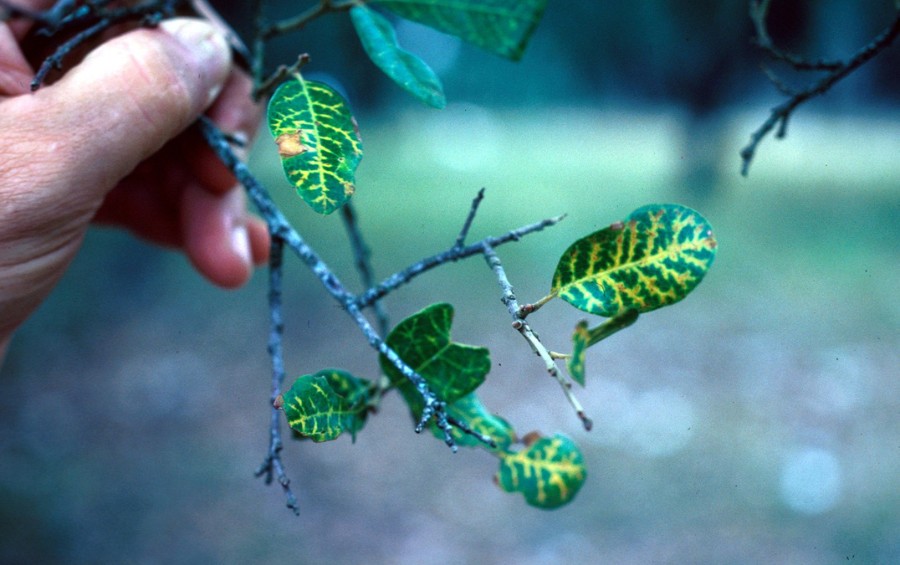
Close up of veinal necrosis. William M. Ciesla, Forest Health Management International, Bugwood.org
How to Tell if Your Oak Tree Has Oak Wilt
Because the symptoms mimic other common tree health problems in the Quad Cities area, accurate diagnosis requires knowing what to look for. Use the list below to evaluate your tree. If you check off more than one item, it’s time to call in a Certified Arborist.
Signs of Oak Wilt
- Brown discoloration starting along the veins (called veinal necrosis)
- Sharp, distinct line between green and brown tissue on the same leaf
- Leaves curling or drooping at the tips
- Leaves falling early in summer, while still green or partially green
- Leaf drop is starting at the top of the tree and working its way down
- The upper canopy is thinning rapidly or looks patchy
- The tree’s overall appearance has changed noticeably in just a few weeks
When It’s Not Oak Wilt
- Browning starts at the edges of the leaf, not along the veins
- The discoloration looks irregular and more diffuse, not sharply defined
- A yellowish halo often surrounds the browning areas
- Leaves stay attached longer and drop is gradual
- Tree decline happens over multiple seasons, not weeks
- Canopy loss is slow and begins from the bottom up
What to Do If You Suspect Oak Wilt
If your tree checks off more than one oak wilt symptom, it’s time to act quickly. Here’s what to do (and not do) next:
Don’t Prune or Trim Anything
Seeing a brown, brittle branch hanging from your oak tree makes you want to grab the saw and clean things up. But, if oak wilt is a possibility, cutting into the tree can do more harm than good.
Fresh pruning wounds attract sap beetles, which are the primary way oak wilt is spread above ground. That one cut could turn your tree into the next infection site or put nearby oaks at risk.
Until a Certified Arborist confirms what you’re dealing with, the best thing you can do is wait.
Call a Certified Arborist That’s Experienced with Oak Wilt
Not every tree service provider has the tools or training to diagnose and manage oak wilt properly. Choose someone who understands how the disease spreads, can correctly identify it, and knows how to contain it. Early confirmation can save other oak trees on your property.
Prevent Oak Wilt from Spreading
If oak wilt is confirmed, the goal becomes containment. That may include removing the infected tree, installing root barriers to stop underground spread, or applying preventative fungicide injections to high-value healthy oaks nearby.
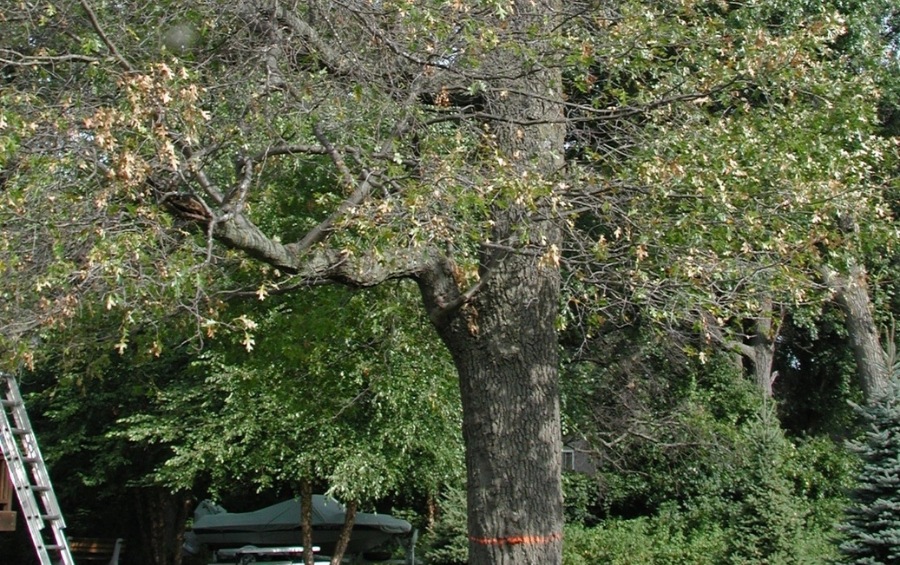
Photo of a tree suffering from oak wilt, courtesy of Joseph OBrien, USDA Forest Service, Bugwood.org
Frequently Asked Questions About Oak Wilt
Can an oak tree with oak wilt be saved?
No, an oak tree with oak wilt can’t be saved. Once infected, every oak species will eventually die – the only difference is how fast it happens. Red oaks decline rapidly, often within 2 to 4 weeks. Live oaks and white oaks may take months or even a couple of growing seasons, but the outcome is the same. To stop the disease from spreading through beetles or root systems, infected trees should be removed as soon as possible.
What prevention methods work best on high-value healthy oaks?
Protective measures include:
- Fungicide injections into asymptomatic high-value oaks, typically reapplied every 1-2 years
- Severing root grafts via trenching to block oak wilt spread underground
- Immediate removal and proper disposal of infected wood before fungal mats form (before April) to minimize beetle attraction
When is it safe to prune oak trees to reduce the risk of oak wilt?
To reduce the risk of oak wilt, avoid pruning oaks from February through July – the peak period for beetle activity. The safest time to prune is midwinter (November-January) when beetles are dormant.
Don’t Wait to Protect Your Oak Trees – Call Advantage Today!
Oak wilt doesn’t give second chances. If you’re seeing symptoms, or just aren’t sure what’s going on, getting expert eyes on your tree now can stop the disease before it spreads, save you thousands in tree removal costs, and give you peace of mind that your landscape is protected.
Don’t guess. Don’t wait.
Call Advantage at 563-355-7508 to schedule a professional tree assessment and get a clear, immediate plan to protect your property and prevent oak wilt from spreading any further.

Get the latest local news, tree care tips, special offers, and company updates directly to your inbox! It's easy to subscribe and there's no spam - we promise.
"*" indicates required fields

